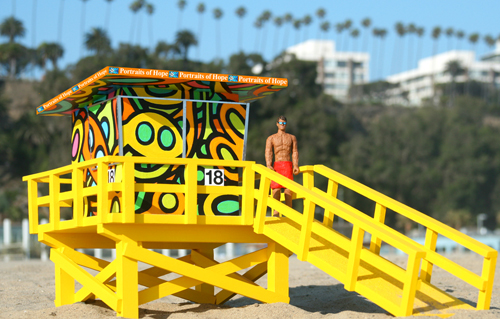The pale blue Los Angeles lifeguard towers that line the coast are iconic symbols of everything that is Californian ““ they represent sun, surf and tranquil vibes.
However, this May, the 158 lifeguard towers from Zuma Beach to Palos Verdes will be transformed into vibrant and colorful “portraits of hope,” courtesy of children from all over the Los Angeles community.
The brains behind this one-of-a-kind community art project are brothers Ed and Bernie Massey, who founded the nonprofit organization called Portraits of Hope. Portraits of Hope began in 1995 when the Massey brothers were inspired by hospitalized and physically disabled children, and decided to provide a way for them to be a part of something beyond their rooms in the intensive-care unit or their wheelchairs.
“For a lot of the kids we work with, their life is only a few city blocks,” Bernie Massey said.
The program engages kids who are facing socioeconomic and physical challenges in a creative process to transform cityscapes into artistic canvases.
Incorporating their collective backgrounds of social entrepreneurship and diverse art forms, the brothers launched Portraits of Hope.
They transformed a run-down tower in Beverly Hills into a public art project, bringing canvases to children in hospitals and allowing them to play a hands-on role in painting something beautiful for their community. Portraits of Hope even created special foot and mouth brushes for kids who are unable to paint with their hands.
“It’s a chance for them to be a part of something truly spectacular,” Bernie Massey said. “And a way for them to say, “˜Hey, I did that.'” Since their founding in 1995, Portraits of Hope has reached out to nearly 100,000 children and 900 organizations, transforming many iconic symbols around the United States and internationally. Some of the projects that they have completed include thousands of New York City taxi cabs painted with flower patterns, four NASCAR racing cars, the Chelsea Piers in New York City, a blimp, an airplane, the Long Beach air traffic control center and schools in Osaka, Japan.
The Massey brothers said that the key to these large-scale civic art projects is the teamwork and cooperation of all of the individuals and groups involved.
“It’s a collaboration,” Ed Massey said. “And it has the potential to make a dramatic change.”
Aside from the child and adult volunteers who have been involved in the execution of the project, the transformation of the Los Angeles lifeguard towers has relied on supporters from every end of the spectrum. County supervisors, the Los Angeles lifeguard and fire departments and perhaps most importantly, the Department of Beaches and Harbors have been instrumental in getting the project off the ground, as well as donors who provided building supplies and paint at discounted prices.
In addition to involving children in a creative therapy process, Portraits of Hope is dedicated to educating the children involved on social issues and how they are instrumental in determining their own futures. The geometric shapes that frequent Portraits of Hope’s projects are representative of children’s ability to shape their own futures.
Stephen Ricci, a close friend of the Massey brothers and long-time volunteer with Portraits of Hope, said that the message they are trying to convey to the kids is that “what you do today determines your tomorrow.”
The organizers of Portraits of Hope accomplish this through their core education program that teaches kids how to integrate their personal ambitions with those of broader social issues in the world.
“We’re trying to show the power of teamwork and collaboration and how social issues require all of us to band together,” Bernie Massey said.
As part of their mission, Portraits of Hope maintains an environmentally friendly and sustainable process through the projects that they complete. All of the materials that are used are recyclable, and many of them are reused in other projects across the globe ““ often being shipped to areas of restoration, such as New Orleans schools after Hurricane Katrina, and eventually to Haiti when the rebuilding process begins. Their panels have ended up in every continent except Antarctica.
“It helps to shrink the world,” Bernie Massey said. “And it’s a chance to be a part of something bigger than ourselves.”
